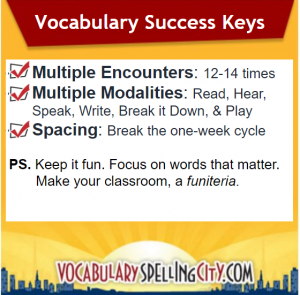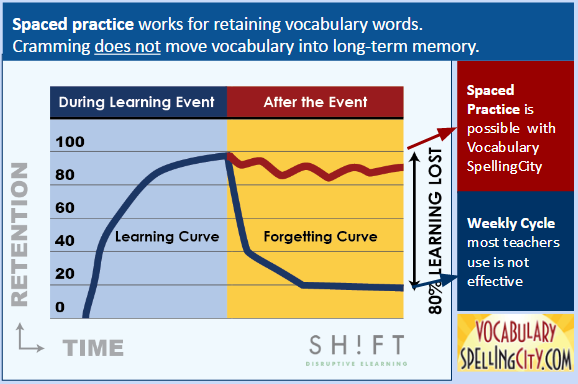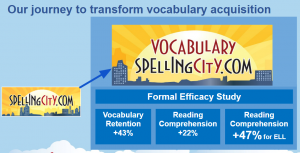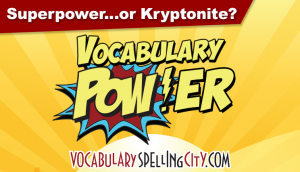
Keys to Vocabulary Success
Vocabulary is responsible for 70% of reading comprehension problems in elementary schools. And while the research is clear on what most students require to build vocabulary (12 spaced multimodal encounters with a word), many schools ignore the research and reading scores suffer. Research shows that with the right techniques for word study used ten minutes a day, reading comprehension can improve by one fifth. It’s proven, low cost to implement, and takes no additional time during the school day.
* * * *
Vocabulary is responsible for 70% of reading comprehension problems in elementary schools. (source: National Research Council study, 4th graders).
Improving elementary students’ reading comprehension by building vocabulary retention is our mission. The challenge that we see across the spectrum of elementary schools and students is consistent: it’s vocabulary. In some Title I schools and schools with ESL populations, it can be Tier I words. In general education and for everyone, it’s Tier 2 words with content and academic vocabulary. No matter where the school is located or type of students, vocabulary is a problem.
A problem is that many schools ignore the research on vocabulary retention strategies. They are also ignoring common sense. We all know that “learn it for Friday’s test, forget it by Monday” is a common problem. Why bother teaching all those words if the students are just going to forget them? Some schools have actually dropped explicit vocabulary instruction (#BadIdea!) adopting the wishful and wrongful thinking that if their students read enough, they’ll absorb the vocabulary that they need. Mostly, this isn’t true.
The research is clear: Twelve to fourteen spaced multimodal encounters with words is the recipe for retention. Here are the key and necessary ingredients again:
- Spaced practice over four weeks. Not lots of practice over one week. Over FOUR weeks.
- Multiple encounters. Not 3, not 7: the research says 12-14
- Multimodal. Just reading a word does not work. Read, write a sentence using each word, break it down by sounds or word parts, count the syllables, play games with it, say it, and read it again.
I’m going to add a fourth ingredient to the mix. Fun. Engagement. Word practice can and should me amusing and engaging. Make your classroom a funeteria. Or a funaterium. And while you are making up words as a way to make those pattern recognition engines (ie your students’ brains) work, you might also speak in rhyme, work with rhythms, sing, dance, and otherwise infuse you and your students’ days with games, joy, and engagement (more on this later. Thanks to Dr. Tim Rasinski for reminding us of the importance and possibilities for joy and how we must fight to keep study from becoming grim!). I digress but by far my favorite part of the CCSS is that starting in kindergarten, students should act out nuances of meaning. I love the idea of classrooms full of students walking / dancing / slithering / marching / sauntering / sneaking and otherwise crossing the room.
Before we get back to the research on vocabulary research, there’s a common confusion about vocabulary that I’d like to clear up. The vocabulary that’s important to learn is not the fancy esoteric elitist $5 SAT-type vocabulary words like supercilious, engender, harangue, obdurate, or ensconce. The important vocabulary words are the Tier 1 & Tier 2 words that are in common usage (often ESL students or students from language deprived backgrounds need exposure here) and the academic and content vocabulary that are the keywords to learning. For instance, many key science and social studies concepts are accessed through vocabulary words such: river, current, lake, delta, fresh water, brackish water, salt water, ocean, tide, and waves. When students learn these important concepts (ie a river has current), their ability to retain them are related to the label or vocabulary word for these concepts
Research Based Vocabulary Study – Lets start with Spaced Practice:

Vocabulary Retention Enabled Through Spaced Practice
The teachers teach ideas and concepts on a weekly cycle. The next week, they need to move onto a new topic and too often, the previous weeks vocabulary lessons and words fade away.
Here’s the concrete steps for a school or district to building a system for improving comprehension by revisiting the concepts and vocabulary over four weeks:
- Train the teachers and the students. Teachers should understand the impact of paying some attention to vocabulary retention. The training should extend to the students so they too understand that the point of the vocabulary study is long-term retention, not just getting through each week’s cycle. Spaced practice, in which the students encounter these words over multiple weeks in different contexts, greatly increases the probability of retention.
- Use a multimedia game-like system so that the students are truly engaged. It’s important that they can hear the words and see them used in context. Play with them. Figure out what they mean. Write with them. VocabularySpellingCity has been designed specifically to provide this spaced multimodal practice with over 35 different learning activities and games covering from writing sentences for each word to breaking each word down phonetically, from vocabulary to spelling. This variety is important if the students are going to work daily on the system.
- Use VocabularySpellingCity’s system with reports for teachers, for parents, and for administrators.
- Assign activities and lists, rather than simply letting students play.
- Look at the recorded data and hold students accountable for both their level of effort and results.
- Leverage students’ reading by asking them to harvest 10 interesting words and create a list on VocabularySpellingCity. Then you can share the list with other students, and the students can teach the words to each other. (If you don’t know about student-created lists, you’re missing a key feature.)
- Measure your progress. As you implement a program for increased vocabulary retention, establish a metric for measuring it either directly or through improved comprehension. One of the trends that needs to be refined in schools is to use testing to encourage and guide success. The point should be formative assessment that’s useful, not high-stakes testing that is so brutal and apparently ineffective.
If you’re interested in the research, there’s a downloadable white paper created by VocabularySpellingCity and McREL International about the field study and another on the academic research behind this approach. Better yet, if you’re interested, give us a call at (800) 357-2157 or contact us online. We can set up your district, school, or classroom rapidly, including plans for ongoing professional development and for measuring your students practice. Let’s work together to make vocabulary your students’ superpower!

Our Journey to Vocabulary
Many users have noticed that our service transitioned from being spelling-based to this new focus on vocabulary
retention to build reading comprehension. Read about Our Journey to VocabularySpellingCity. I think many schools and teachers are also transitioning along similar paths. The summary is that from our SpellingCity’s legacy, we remain committed to gamification, student empowerment, and teacher productivity. It is on this foundation that we built a system for vocabulary building fully aligned with today’s highest priority in education: improved comprehension.
The critical missing element in building comprehension (verbal and reading) is vocabulary and VocabularySpellingCity is on mission to spread the words about the importance of implementing effective vocabulary retention techniques in classrooms.

